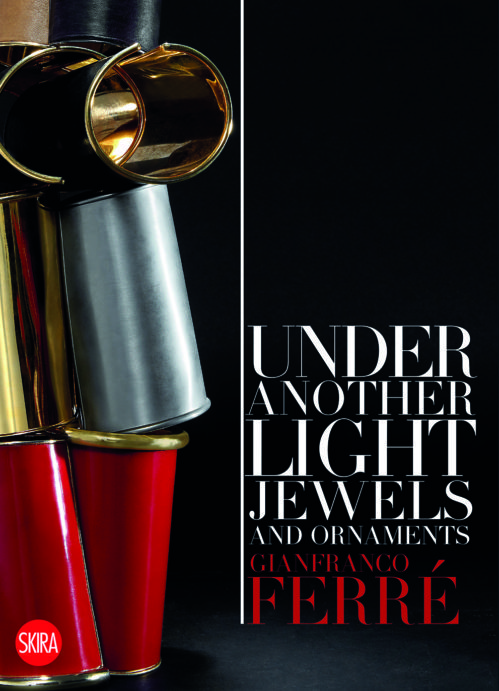I thought I knew a bit about the Italian fashion giant Gianfranco Ferré, after all I used to own one of his bags but, as it turns out, that was a bit of a red herring; because it was through that bag that I made a lot of assumptions. The main one being that the designer was another in a long line of Made-in-Italy brands with its origins in leather goods like Prada, Bottega Veneta and Gucci. Not so, the new book, Under Another Light, reveals his unlikely journey from his formal training as an architect and then into his boldly sculptural jewellery, which became a strong feature of his collections when he later turned to womenswear design.

Ferré was born in 1944 in Legnano, Italy and died in Milan aged 62. His fashion trajectory began with jewellery in 1970, reaching its peak during the ’80s when he designed multiple ready-to-wear collections, licenced products including jeans and fragrances, and a couture collection in Rome. In 1989 he was approached by Bernard Arnault, from LVMH to head the house of Christian Dior in Paris. In our current era of disruption this tactical manoeuvring is the norm, consider the recent appointment of Riccardo Tisci at Burberry or the unsettling forces of Demna Gvasalia at Balenciaga or Alessandro Michele at Gucci, but back then, the appointment of Ferré to this established French house would have sent shockwaves through the fashion industry.
Gianfranco Ferré was his own man; he was critical of the fashion system and, as he saw it, the gimmicky nature of fashion trends. This strength and single-mindedness shows in the way he approached jewellery design. The publishers of the book, ‘Under Another Light’ searched for sketches related to his ornaments but found very little, highlighting the way he preferred to create, through direct interaction with prototypes and hands-on experiments with materials.
It seems dismissive to call the pieces costume jewellery, even ornaments, because the forms are so powerfully dynamic and precision-crafted, and yet because he avoided using precious metals they are not categorised as fine jewellery. In my view his work balances the two – utilising the craftsmanship usually reserved for precious metals while pushing the boundaries of costume jewellery.
Ferré’s fascination with Indian decoration is documented in interviews; “Gleaming or subdued gold, silver with all of its reflective glints, poor metals that nevertheless gleam with the same richness as precious ones, gems that set off a phantasmagoric kaleidoscope…I seized upon it making it a vital part of the realm of my imagination, interpreting it in my collections”. Ferré found his inspiration everywhere from Amazonian tribes and French cabinet makers to organic natural forms, purposefully choosing unconventional combinations: iron, copper wire, wood, shells, crystals and glass over traditional materials.
When we talk today about empowering women through fashion, we see designers use different approaches, some turn towards masculine shapes, others choose overtly feminine styles, while some want to break down the codes of dress completely. Through his jewellery design, Ferré shows us his version of empowerment, maybe even his defiance in the face of tradition trapped within these fierce, primitive shapes. Styles which challenge the wearer to rise to the occasion and be emboldened; surely it would have been impossible to wear his statement pieces without absorbing some of that confidence?
Ferré’s ornamental pieces appear so entrenched in his design process that they became pivotal to his catwalk collections, punctuating the styles with fierce statements. In his own words “In my imagination, jewels help me to ‘construct’ the body, to sculpt it with clarity.” He was known as the king of the white shirt, sculpting his silhouettes with powerful architectural lines and knew instinctively how to make the eye travel along a design, controlling the viewer’s gaze with accents: adding a brace-like collar, a stack of industrial cuffs or a statement belt.
In the first year after the death of Gianfranco Ferré, Lars Nilsson was appointed to the position of creative director before being replaced by 6267 designers, Tommaso Aquilano and Robert Rimondi. This came to an end in 2011 when Stefano Citron and Federico Piaggi took over. Today the brand is no longer the powerhouse it once was, but the name continues to live on through the Gianfranco Ferré label, Ferré diffusion, GF Ferré activewear line, fragrances and home interiors.
Revisiting his work now makes me wish I still had my Gianfranco Ferré bag, unfortunately it was stolen along with its contents in 1995, from a London showroom – I guess all great things come to an end.
Gianfranco Ferré. Under Another Light: Jewels and Ornaments
Rita Airaghi – the Director of the Fondazione Gianfranco Ferré
Art direction by Vogue Italia’s Luca Stoppini
Published March 2018 by Skira
ISBN: 978-88-572-3669-8
